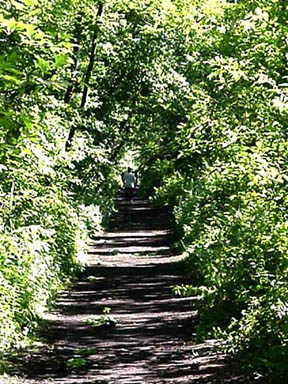Beach Channel Park
The Daily Plant : Thursday, March 27, 2003
A HIKE FOR EVERY BOROUGH

Now that spring has arrived, there’s no excuse to stay inside. You owe it to your sunlight starved body to get outside and take a long walk. Spring is an elusive season—it’s here and gone before you know it—and this weekend will be one of the few times you’ll be able to see budding trees, just-bloomed crocuses, and overflowing streams and puddles. There are dozens of trails all over the city that are perfect for rediscovering the great outdoors. Some of the city’s best hikes are listed below, but for a complete overview of hikes in your neighborhood park, call the Urban Park Rangers—they might even be hosting a guided hike somewhere near you. It’s also a good idea to check with the Rangers to get an update on trail conditions, especially if the weather has been rainy. To find the Urban Park Ranger station closest to you, call 1-866-NYC-HAWK.
In Brooklyn, the Salt Marsh Nature Trail is especially beautiful this time of year. The trail lies at the westernmost inlet of Jamaica Bay in Marine Park and begins at the Salt Marsh Nature center. About a mile long, the trail is a gravel path that follows the edge of the salt marsh, giving hikers glimpses of wetland wildlife. In the spring, red-winged blackbirds sing among the cattails and Beach Plum, Henbit and Purple Dead Nettle bloom. A bridge at the beginning of the trail offers hikers a place to look for fiddler and horseshoe crabs. In late spring, the new growth of plants and flowers sometimes becomes so thick that they nearly engulf the trail, creating a green buffer that surrounds the trail and muffles urban distractions.
A hike through Alley Pond Park in Queens will lead you around glacial "Kettle Ponds." The park lies on a glacier-formed ridge of sand and rock that marks the southern terminus of the Minnesota Ice Sheet. The "Kettle Ponds" were formed by buried chunks of ice that melted and formed pools when the glacier receded. Water drains into the valley from the hills and bubbles up from natural springs, mixing with the salt water from Little Neck Bay. The ponds are host to freshwater and saltwater wetlands, tidal flats, meadows, and forest, creating a complex ecosystem that gives curious hikers a huge variety of animal and plant life to observe.
To really get away from it all, hop on the Staten Island ferry and head to High Rock Park. Covering nearly 100 acres, High Rock park contains five ponds and various wetlands, including Walker Pond and Loosestrife Swamp. Beginning hikers can wander at a leisurely pace through stands of red maples, highbush blueberries and patches of skunk cabbage. More adventurous hikers can climb Mt. Moses, a 260 foot hill named for former Parks Commissioner Robert Moses. Because the trees are still in bud, the overlook at the top of the mountain is panoramic this time of year, with views of the Raritan Bay. Many of the trails in High Rock Park are connected, so ambitious hikers can walk for several hours through the woods, encountering few people and crossing only one or two roads. A variety of wildlife abounds on these trails: wood ducks, great blue herons, muskrats, hawks, owl, woodpeckers, frogs and turtles.
In the Bronx, a great spring hike is Van Cortlandt Park’s John Muir Trail. Named for the famous naturalist, the trail is an unusual one because it runs on an east/west axis. Those looking for a strenuous, uphill hike should start on the western side, at Broadway and Mosholu Avenue, and head east. For an easy, downhill walk, hikers should start on the eastern side at Oneida Stree and Van Cortland East. The trail takes hikers past the Old Croton Aqueduct and the Mosholu Golf Course. In the springtime, there are often impromptu streams, flowing as a result of increased rainfall. There are lots of animals to be seen, and the luckiest, quietest hikers may even catch a glimpse of the coyotes that live in the forests.
Finally, in the upper reaches of Manhattan there’s a lovely out-and-back hike which begins and ends at the Inwood Hill Nature Center. The entire hike takes about an hour and half, when walked at an average pace. Beginning at the nature center, the trail winds around the salt marsh and the famous Shorakapok Rock, the site upon which—as legend has it—the island of Manhattan was sold. The trail then takes hikers past a Native American rock shelter, and through one of the best bird-watching areas in the city, known as "The Clove." After hikers have had their fill of cardinals, titmice, and woodpeckers, the trail continues on to Overlook Meadow, which boasts a spectacular view of the Hudson River and the New Jersey Palisades. From here, hikers can choose their own adventure: for a longer, more challenging walk, they can take a winding path back to the nature center by heading downhill and underneath the Henry Hudson Bridge. Beginning hikers should turn around at Overlook Meadow and head back to the way they came, re-experiencing the all the delightful spring views for a second time.
QUOTATION FOR THE DAY
"All the things I really like to do are either immoral, illegal, or fattening."
Alexander Woollcott
(1887-1943)

